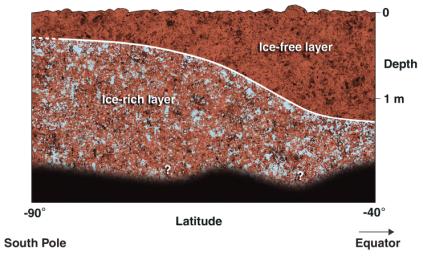
|
Cross-Section of Icy Soil
- Click the image above for a larger view
- Full-Res JPEG (1764 x 1068) (421.9 kB)
- Full-Res TIFF (1764 x 1068) (2.7 MB)
Caption:
This diagram shows a possible configuration of ice-rich and dry soil in the upper meter (three feet) of Mars. The ice-rich soil was detected by the gamma ray spectrometer suite of instruments aboard NASA's 2001 Mars Odyssey spacecraft. Measurements indicate that the uppermost soil contains very little ice, while an ice-rich zone below contains 20 to 50 percent ice by mass. The depth of the ice-rich layer becomes shallower toward the south pole, as shown on the left of the diagram. The instruments detect the signature of hydrogen, indicating water ice, to a depth of about one meter (three feet). It is not known whether or how deep the ice-rich zone continues below that depth.
Background Info:
NASA's Jet Propulsion Laboratory manages the 2001 Mars Odyssey mission for NASA's Office of Space Science, Washington, D.C. Investigators at Arizona State University in Tempe, the University of Arizona in Tucson, and NASA's Johnson Space Center, Houston, operate the science instruments. The gamma-ray spectrometer was provided by the University of Arizona in collaboration with the Russian Aviation and Space Agency, which provided the high-energy neutron detector, and the Los Alamos National Laboratories, New Mexico, which provided the neutron spectrometer. Lockheed Martin Astronautics, Denver, is the prime contractor for the project, and developed and built the orbiter. Mission operations are conducted jointly from Lockheed Martin and from JPL, a division of the California Institute of Technology in Pasadena.
Cataloging Keywords:
| Name | Value | Additional Values |
|---|---|---|
| Target | Mars | |
| System | ||
| Target Type | Planet | |
| Mission | 2001 Mars Odyssey | |
| Instrument Host | Mars Odyssey | |
| Host Type | Orbiter | |
| Instrument | Gamma Ray Spectrometer (GRS) | |
| Detector | ||
| Extra Keywords | Color, Water | |
| Acquisition Date | ||
| Release Date | 2002-05-28 | |
| Date in Caption | ||
| Image Credit | NASA/JPL/University of Arizona/Los Alamos National Laboratories | |
| Source | photojournal.jpl.nasa.gov/catalog/PIA03803 | |
| Identifier | PIA03803 | |
